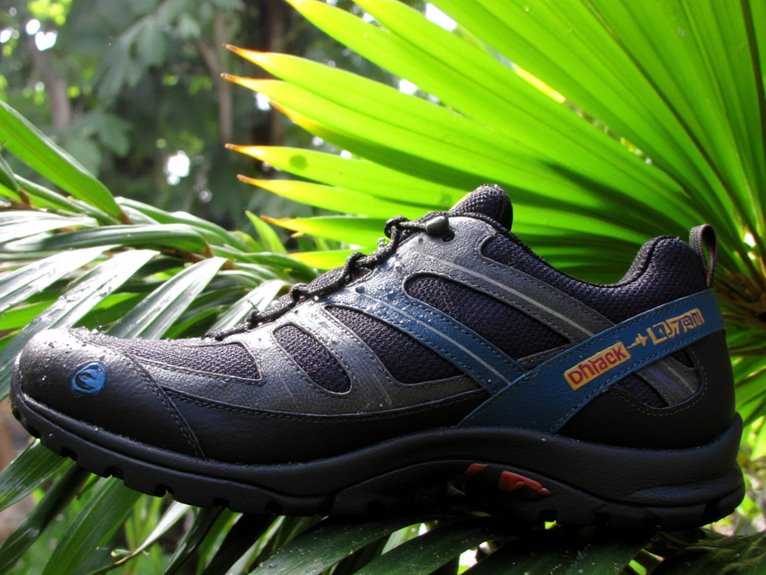What Makes Good Footwear for Tropical and Humid Environments?
You’ll need footwear with breathable mesh uppers and moisture-wicking synthetic fibers that create airflow channels for rapid evaporation. Look for drainage systems with removable insoles and injection-molded soles that self-clean while shedding water instantly. Essential features include FeelTrue rubber outsoles with multi-directional tread patterns for superior wet-terrain grip, puncture-resistant midsoles, and lightweight EVA construction that reduces weight by 30-40%. Quality options maintain 3000-5000mm waterproof ratings while offering reinforced toe protection. Understanding these technical specifications will guide your selection toward ideal tropical performance.
We are supported by our audience. When you purchase through links on our site, we may earn an affiliate commission, at no extra cost for you. Learn more. Last update on 18th December 2025 / Images from Amazon Product Advertising API.
Notable Insights
- Breathable materials with mesh panels and moisture-wicking technology prevent fungal infections by creating airflow channels and reducing internal dampness.
- Superior grip performance through specialized rubber compounds and multi-directional tread patterns ensures safety on wet and slippery tropical surfaces.
- Rapid drying technology with drainage channels and removable insoles enables quick water evacuation and moisture evaporation after exposure.
- Lightweight synthetic construction reduces fatigue during extended wear while maintaining durability against humid conditions and frequent wet-dry cycles.
- Puncture-resistant soles and reinforced toe caps provide essential protection against sharp debris while preserving flexibility for natural foot movement.
Maximizing Airflow and Moisture Management
When selecting footwear for tropical climates, moisture management becomes your primary defense against discomfort and potential health issues. Effective shoes incorporate breathable materials with engineered porosity that create airflow channels throughout the construction.
These channels promote continuous air circulation, preventing heat build-up inside your footwear. Modern fabric innovation utilizes synthetic fibers like polyester and nylon with hydrophobic properties.
These materials employ capillary action to draw moisture from your skin to the fabric surface where it evaporates quickly. Micro-channel fiber designs increase surface area mechanically, speeding both absorption and evaporation processes.
Multi-layered moisture management systems work systematically. Inner layers wick sweat away from your feet, while outer breathable layers facilitate evaporation. Additionally, moisture-wicking technology minimizes skin irritation by maintaining consistent dryness during extended wear in humid conditions.
This graduated moisture transport reduces prolonged dampness, lowering your risk of fungal infections and bacterial growth in humid environments. Breathable fabrics with zoned ventilation prevent overheating during extended wear in tropical conditions. High-performance socks made with highly-engineered nylon fibers provide superior moisture wicking that accelerates the absorption and evaporation process for optimal foot comfort.
Fast Water Evacuation and Rapid Drying Technology
Beyond moisture-wicking capabilities, effective tropical footwear must rapidly evacuate standing water and dry completely between uses.
Water evacuation systems integrate specialized drainage channels under insoles and self-cleaning sole designs that prevent moisture buildup. Quick-release closures with large openings accelerate water removal, while breathable membranes paired with engineered soles allow water exit without compromising waterproof integrity.
Technologies like Hydro-Tec® enable near-instant evaporation through moisture-wicking linings.
Rapid drying materials include PU/leather combinations with Cordura fabrics and lightweight textiles with water-repellent finishes. Neoprene synthetic liners dry faster than cotton alternatives.
Essential rapid drying features you need:
- Drainage channels – Direct water away from your feet instantly
- Removable insoles – Create airflow for accelerated moisture removal
- Mesh linings – Transport water outward efficiently
- Injection-molded soles – Self-clean while shedding water continuously
Superior Grip Performance on Wet and Slippery Terrain
Traction becomes the critical safety factor that separates reliable tropical footwear from potentially dangerous slip hazards on wet terrain.
You’ll need specialized outsole materials like FeelTrue rubber compounds that deliver superior water traction on slippery surfaces.
Salomon’s Water Contragrip technology provides sticky grip in muddy conditions and underwater environments.
Deep, pronounced lugs bite into algae-covered rocks while multi-directional tread patterns maximize ground contact.
The ideal sole thickness of 3-5mm balances flexibility with slip resistance. Open mesh tread designs self-clean mud and debris to maintain consistent grip performance.
Your footwear should handle shifts from dry trails to wet creek bottoms reliably.
Reinforced toe caps combined with textured soles improve security on rocky surfaces.
Neoprene booties offer thick, textured soles for maximum traction on boards and slippery rocks.
For optimal safety on varied terrain, look for outsoles with 3-7mm lug depth that provide enhanced bite and stability across wet surfaces.
Just as hunters rely on multi-coated lenses for clear vision in challenging outdoor conditions, tropical footwear must incorporate advanced grip technologies to maintain safety across varying wet terrain conditions.
Lightweight Design for Enhanced Mobility and Comfort
Superior grip means nothing if your footwear weighs you down during extended tropical adventures.
Lightweight design directly impacts your endurance and agility on challenging terrain. Advanced synthetic mesh uppers and EVA midsoles reduce weight by 30-40% compared to traditional leather boots while maintaining durability.
Advanced materials slash footwear weight by up to 40% without sacrificing the rugged durability tropical adventures demand.
Flexible soles encourage natural heel-to-toe movement, adapting to varied surfaces without restricting your gait. Adaptive fits mold closely to your foot shape, eliminating internal movement that causes fatigue.
Key benefits of lightweight tropical footwear:
- Reduced joint stress prevents knee and ankle strain during long hikes
- Enhanced balance keeps you stable on slippery rocks and muddy trails
- Faster drying eliminates soggy, heavy shoes after water crossings
- All-day comfort supports extended wear without foot fatigue
Low-profile cushioning maintains shock absorption while minimizing bulk, essential for maneuvering uneven tropical surfaces efficiently.
Essential Protection Features for Challenging Tropical Conditions
When you’re traversing tropical environments, your footwear must shield you from multiple hazards that can cause serious injury or mission failure.
You’ll need reinforced toe caps and foot guards to protect against blunt impacts, while specialized sole technology defends against sharp debris like thorns, coral fragments, and punji stakes.
Your ankle support system must balance protection from twisting injuries with the mobility required for uneven terrain and rapid movement.
Additionally, flexible materials that allow natural foot movement are crucial for maintaining agility across varied tropical terrains while providing immediate comfort during extended missions. Look for boots with deep heel cups that enhance stability and proper foot alignment when navigating challenging tropical terrain.
Toe and Foot Guards
Composite toe caps excel in tropical conditions because they’re non-metallic and won’t conduct heat like steel alternatives. These materials meet ASTM safety standards while providing superior thermal insulation.
You’ll experience greater mobility and breathability compared to traditional metal guards.
Consider these critical protection features:
- Abrasion-resistant guards that withstand crushing impacts from falling debris
- Moisture-wicking materials that prevent dangerous fungal infections
- Ventilation systems that maintain comfort during extended wear
- Flexible construction that reduces pressure points and blistering
Your toe guards must balance maximum protection with ergonomic design to prevent fatigue.
Sharp Debris Defense
Sharp objects scattered across tropical terrain can turn your workday into a medical emergency.
You need puncture-resistant midsoles that stop nails, metal scraps, and glass from penetrating your shoe’s sole. PS rated aramid protective midsoles deliver high puncture resistance while maintaining flexibility and low weight.
Non-metallic midsoles provide safety without added bulk or metal detector interference.
These thin but durable layers protect your feet without compromising comfort on uneven ground. The best designs combine puncture resistance with shock absorption to reduce fatigue on debris-laden surfaces.
Pair this protection with slip resistance technology.
Deep treads with square lugs push away mud and leaves like squeegees. Nitrile rubber outsoles maintain superior traction on wet, oily terrain common in tropical environments.
Vibram outsoles with self-cleaning deep lugs provide exceptional grip and debris removal on challenging tropical surfaces where mud and vegetation create treacherous footing.
Reinforced toe and heel construction adds another layer of defense against sharp rocks and thorns that can puncture through reinforced construction during extended exposure to harsh tropical conditions.
Ankle Support Balance
Although ankle injuries rank among the most common workplace hazards in tropical environments, proper ankle support can dramatically reduce your risk of sprains and fractures on uneven terrain.
High-cut boot collars provide structural stability by encasing your ankle joint, while reinforced padding absorbs shock from rocky surfaces. These ankle support benefits extend beyond injury prevention—they enhance proprioception improvement, helping your body maintain better balance awareness on slippery mud and wet surfaces.
Key ankle support features for tropical conditions:
- Adjustable lace-up closures lock your ankle securely without restricting natural movement
- Lightweight construction materials prevent fatigue during extended jungle treks
- Breathable mesh panels reduce moisture buildup that causes fungal infections
- Dual-density foam cushioning distributes pressure evenly across uneven ground
Many outdoor enthusiasts appreciate footwear that maintains warmth without bulk, essential for active use while providing the structural support needed for challenging tropical terrain. Additionally, breathable construction in footwear prevents moisture buildup around the ankle area, ensuring comfort during intense physical activity in humid tropical conditions.
Moisture-Resistant Material Construction
Key construction features include:
- Sealed seams with waterproof tape – Eliminates vulnerable stitch points where water penetrates
- Rubber uppers with protective coatings – Creates seamless barriers against wet conditions
- Breathable mesh linings – Reduces internal moisture buildup
- Reinforced materials – Withstands repetitive water exposure without losing strength
Quality boots with seam-sealed technology can maintain waterproof effectiveness for extended periods, with some models providing reliable protection for 900-1000 miles of use.
Similar to outdoor gear, footwear should maintain waterproof ratings between 3000-5000mm to ensure reliable protection against heavy moisture in tropical conditions.
Abrasion Protection Features
While moisture resistance keeps your feet dry, abrasion resistance determines whether your footwear survives the harsh realities of tropical terrain. Your boots need full-grain nubuck leather or synthetic materials that won’t deteriorate under constant friction from rocks and debris.
Protective overlays become critical in high-wear zones. Rubber rands wrap around toe and heel areas, creating barriers against scuffs and impacts. Multi-row stitching reinforces seams that face repeated stress from wet-dry cycles. Reinforced toe caps provide essential protection in rocky environments.
Quality outsoles use compounds like Vibram® Panama for superior wear resistance. Omni-directional tread patterns maintain grip while resisting surface abrasion.
Firm heel counters and supportive collars reduce material stress, preventing premature failure. These features guarantee your footwear endures tropical punishment.
Frequently Asked Questions
How Often Should I Replace Tropical Footwear Compared to Regular Hiking Shoes?
You’ll need to replace tropical footwear every 6-12 months versus 9-18 months for regular hiking shoes. Tropical shoe materials break down faster due to humidity, while regular footwear durability extends longer in drier conditions.
Can I Use Regular Athletic Shoes for Short Tropical Hikes Instead?
You can use athletic shoes for short tropical hikes, but they’ll lack proper traction on wet surfaces and waterproofing. Choose well-ventilated options with decent treads and avoid deep water crossings.
Are Waterproof Shoes Better Than Water-Resistant Ones for Tropical Environments?
Water-resistant shoes are generally better for tropical environments. While waterproof benefits include complete water exclusion, they trap heat and reduce breathability. Water-resistant options offer superior moisture management and comfort in humid conditions.
Should I Size up or Down When Buying Tropical Footwear for Swelling?
You should size up when buying tropical footwear to accommodate expected foot swelling. Consider swelling considerations like daily expansion and choose footwear materials that’re breathable and flexible to maintain comfort throughout the day.
On a final note
You’ll need footwear that combines breathable mesh uppers, quick-drain midsoles, and aggressive tread patterns for tropical environments. Don’t compromise on antimicrobial treatments and reinforced toe protection. Your shoes must handle 90% humidity levels while maintaining grip on wet surfaces. Choose lightweight designs under 12 ounces that won’t slow you down. Quality construction with sealed seams and corrosion-resistant hardware guarantees your investment survives harsh moisture conditions long-term.

